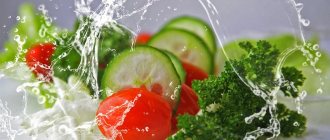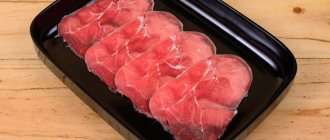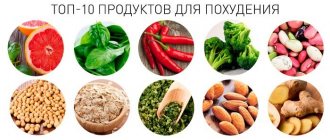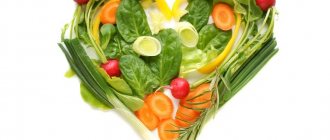Ayurveda for weight loss nutrition rules When I first heard the word Ayurveda, I decided that it was someone’s last name, or first name, in extreme cases. Subsequently, I was very surprised to learn that this Indian technique is a real science of life.
However, first things first. My interest in this system did not arise by chance. My legs began to hurt badly and the doctor advised me to pay attention to my body weight. He said that Ayurveda (Ayurveda) would be suitable for me.
It is safe for health and good for weight loss. The nutrition rules there are not complicated, you can always find food, the main thing is to want it. It's been 2 years already. The weight gradually returned to normal. I only remember about my legs after heavy loads.
Key points of nutrition according to Ayurveda - about the doshas
Dosha is a complex concept in the Ayurvedic system, which combines the constitutional characteristics of the human body, character, and temperament. A harmoniously developed personality consists of three balanced doshas, but in reality such a standard is rare.
More often than not, one or the other dosha pulls the blanket over itself. To find out the percentage of doshas in your body, you can use one of many tests. The test requires at least 30 minutes of free time and thoughtful answers that impartially characterize the state of your body, well-being, and attitude.
Dosha Vata
Externally, people of Vata constitution are distinguished by thinness, bonyness, long limbs, narrow chest, and protruding joints. Metabolic processes in their body proceed extremely quickly.
As a result, this category of people is generally not inclined to be overweight. They have another problem - the inability to get better even with a strong desire. According to Ayurveda, weight loss is not recommended for Vata people, because it threatens exhaustion.
The Vata person is impetuous, chaotic, cheerful, has a wonderful imagination and a great sense of humor. A cheerful fellow and the life of the party. Among the disadvantages of this wonderful constitution are susceptibility to nervous breakdowns, cardiovascular diseases, and endocrine diseases.
As for nutrition, in order to gain a little weight and balance other doshas, it is necessary to increase the amount of sweet, flour, and oily foods. But you need to avoid spicy, bitter and astringent foods (such products enhance metabolic processes and lead to weight loss).
Dosha Pitta
People with a Pitta constitution have an average build, moderately muscular and of acceptable stature. They have a good appetite, sometimes excessive. They gain weight easily and lose it just as easily. Among the main problems are diseases of the digestive system and skin.
The main reason for obesity in the case of Pitta is simple overeating.
Although a Pitta person rarely suffers from obesity, he gains weight easily within the range of 5–10 kg. Losing weight according to Ayurveda for this constitution involves following a number of recommendations:
- increase the volume of bitter and astringent products (leaf lettuce, broccoli, artichokes);
- reduce the proportion of sour, salty, spicy;
- do not overeat, eat regularly and nutritiously;
- try to eliminate dairy products, nuts (lots of fat);
- Choose sweet fruits (grapes, melon), limit sour ones (grapefruits);
- the main source of protein is chicken, reduce the consumption of beef and seafood;
- lean on rice and oats, limit the amount of corn and rye;
- fasting days are not only acceptable, but also recommended.
Remember, if you are Pitta and suddenly gain weight, most likely you are abusing your appetite. Moderate it and you will be slim.
Dosha Kapha
Kapha is the fattest of the doshas. People of this constitution have a large build and are prone to rapid weight gain and slow weight loss.
In life, Kaphas are peace-loving, sentimental, and stress-resistant (unlike Vata). Health threats include obesity, endocrine diseases, and allergies.
An effective way to lose weight according to Ayurveda for Kapha is to strictly follow the rules:
- sweet, sour and salty are prohibited;
- emphasis in nutrition - on spicy, astringent, bitter;
- avoid overeating (Kapha gets better even from the thought of food);
- give up dairy products;
- greatly reduce the amount of fat;
- rice, wheat, corn, oats are prohibited;
- bananas, melon, avocado are also in the TOP excluded;
- prefer vegetables to any meat (with the exception of potatoes, tomatoes and zucchini).
For Kapha, aerobic exercise is an important rule for losing weight. Their metabolism is greatly slowed down. It needs to be regularly stimulated, and the best way to cope with this is through a load that increases the heart rate.
In addition to specific recommendations, losing weight according to Ayurveda means following general nutritional rules. “The Science of Life” gives competent instructions on organizing your diet. And they apply to all three types of doshas. Source: ezoterik-page.com
General principles of nutrition
If you write a complete list of stars who not only listen to Ayurveda, but follow it, it will take up a lot of space. Among the followers of this trend are Kate Winslet, Cindy Crawford, as well as Gwyneth Paltrow, Natalie Portman, Christina Ricci, Oprah Winfrey, Jennifer Aniston and others.
Ayurvedic nutrition is not a regular diet, but nutrition that is associated with the energy and characteristics of your body, constitution, and natural data. Therefore, it is simply impossible to break the habit of long-standing eating habits in one day and immediately begin to follow the recommendations of Ayurveda. You need to come to this, you need to delve into this philosophy.
9 principles of nutrition according to Ayurveda for weight loss and more:
- This is not a diet - some will be disappointed by such a statement, but others, on the contrary, will be inspired. This is a natural nutrition that will allow you to stay in physical health longer, and therefore at a normal weight.
- The ideal breakfast is different for each type. For vata, this is porridge with dried fruits in butter or milk, and also a warm, pleasant drink, for example, ginger tea. For breakfast, a pitta type can choose a fruit salad, nuts, full-fat milk or express porridge. Kapha can avoid breakfast and replace it with good tea. An alternative in the form of a smoothie, but without a dairy base, is not excluded.
- Food can affect your condition in different ways. For example, tamasic food provokes laziness and makes you sleepy (fast food, heated food, canned food). Rajasic foods increase passion and focus on activity (salty, spicy, sour). Sattvic food lifts your mood and increases your intellectual capabilities (light foods, natural sweets, honey).
- After eating, you cannot lie down, sit, or run. But going for a walk, doing something physically leisurely, but still involving dynamics, is possible and necessary.
- The recommended one-time amount of food is the one that fits in two of your cupped hands. The required amount of drink is what will quench your thirst.
- You can’t eat until you’re full, you absolutely can’t eat until your stomach feels heavy.
- Prepare food only in a clean place, with clean thoughts and in a good mood. First, wash the dishes, work surfaces and floor, and start cooking clean.
- The basis of the menu is cereals, and vegetables are a harmonious addition to them.
- The best food is considered to be fresh food, that which is prepared a maximum of 2 hours before the meal. The food should preferably be warm, but preferably not reheated and not very hot.
Ayurveda for weight loss, nutrition rules, features of the ancient oriental diet
The principles of the ancient Indian teaching of Ayurveda have been preserved in the Vedas to this day. They can be successfully used not only to improve your well-being, but also to lose weight.
Basic rules of nutrition according to Ayurveda
- Eat only natural, healthy food. It should be prepared shortly before the meal and only in a good mood;
- Eat fresh vegetables and fruits in raw form;
- Eat only when you feel hungry, but it is better to refuse to eat if a person feels tired or is in a bad mood;
- Combine only compatible foods in one meal, so as not to weaken the body with excess toxins;
- You should fast from food once a week and never eat before bed;
- Include 6 tastes in the diet: bitter, spicy, salty, astringent, sour and sweet;
- Avoid taking fruit juices and drinks;
- Use spices;
- Eat slowly, chewing everything well;
- Trust your inner feeling, eat what you want.
Source: ayurveda-info.ru
Followers of Indian medicine explain excess accumulation of fat in the body by slagging. Poorly digested and not fully absorbed food is broken down with the formation of waste substances.
The latter come in two types: water-soluble and fat-soluble. Toxins of the first type can be easily eliminated through exercise and fasting nutrition. But with the second type of toxins, everything is more complicated, since they remain in the cells of the body and cause increased synthesis of fat molecules.
However, the situation is not hopeless. Doctors practicing Ayurvedic principles have developed special methods for cleansing the intestines and the body as a whole. With their use, a person is able to achieve certain success in losing weight and normalizing metabolic processes.
Diet
This is one of the basic principles and must be observed constantly. Ayurvedic teachings recommend starting the day at 5–6 am, and finishing, that is, going to bed, at 10 pm. This time is justified from a physiological point of view - the activity of the liver, which plays the main role in detoxification, is active around one in the morning.
If a person is not yet sleeping at this time, the liver works “at low speed” and the level of toxins in the body not only does not decrease, but also increases.
Meals should be three times a day: breakfast, lunch and dinner. But there is one exception to keep in mind: three meals a day is not suitable for people with low blood sugar.
In the morning you should have a full healthy breakfast. With this daily routine, lunch should be at 12–13 o'clock. Dinner should be planned approximately 4 hours before going to bed so that the gastrointestinal tract has time to fully digest the food eaten.
The most abundant food in terms of volume is lunch - it accounts for 50% of the daily diet. Breakfast and dinner should be 25% each.
Natural products
All products used in food must be natural, without the addition of preservatives, flavor enhancers, dyes and flavors. In addition, Ayurveda recommends consuming seasonal products. That is, vegetables and fruits bring the greatest benefit at the time when they ripen.
One-day unloading
To lose weight and cleanse, Ayurveda recommends a so-called fast once a week. This could be a regular fasting day.
Ayurveda is a fundamentally different view of slimness. She does not dictate strict standards, but prefers to stick to the golden mean. She does not prohibit, but recommends.
The menu for fasting must be selected individually, based on your own constitution, time of year and state of health.
Drinking regime
This point of the nutritional rules according to Ayurveda states that drinking water before or immediately after meals is undesirable. The ideal option is to drink clean water in small portions (several small sips) throughout the day. It is strictly not recommended to drink cold water, especially after meals.
Combination of flavors
This principle of nutrition is given great importance in Ayurveda. And it is also important for losing weight. There are only six flavors:
- sour
- sweet
- salty
- bitter
- spicy
- astringent
The menu for each day should be designed in such a way that these tastes are represented to the maximum in the dishes. This task can be greatly facilitated if you use an Ayurvedic fat-burning seasoning. Source: m-figura.ru
Proper nutrition is the key to losing weight
Daily consumption of natural, healthy and fresh foods is the basis of the Ayurvedic nutrition system. A properly selected diet will ensure good digestion of food and help burn extra pounds. This system involves eating mainly foods of plant origin and dairy products with a small percentage of fat. For breakfast, according to Ayurveda, the best option would be fruits, cereals and low-fat cottage cheese. For lunch, stewed vegetables, salads, steamed rice and vegetable soups are suitable. Dinner should be light and not contain a large amount of carbohydrates, so you should avoid sugar. All products must be combined correctly. As for drinks, the best options for this diet are water, freshly squeezed juices, low-fat yoghurts and compotes . You should also eat two fresh or dried fruits every day.
The principle of "six tastes"
Ayurveda distinguishes six basic tastes that all foods have.
- Sweet taste is present in foods such as rice, milk, sugar, wheat, honey, dried fruits, buckwheat, carrots, beets, pears, grapes, potatoes, onions, some berries, melon. They provide a quick release of energy, producing an invigorating effect. Sweet-tasting foods stimulate the production of serotonin, which gives you a feeling of pleasure. However, it is important to know that foods with a sweet taste contribute to obesity, poor digestion, fermentation in the intestines and the onset of diabetes. For people prone to Kapha, it is best to completely exclude them from the diet or consume them little by little in the morning.
- Most berries, citrus fruits, fermented milk products, rhubarb, tomatoes, pineapples, papaya and vinegar have a sour taste. If used wisely, they effectively improve digestion and give vigor and energy. Excessive consumption can cause increased appetite, heartburn and stomach ulcers.
- The salty taste is characteristic of meat, salt, seaweed, soy sauce, and miso paste. Moderate consumption of salty foods maintains and restores a healthy water-salt balance in the body, improves digestion and absorption of food. An excess of salty foods leads to edema, additional stress on the kidneys, increased appetite, deterioration of blood circulation and skin condition.
- We feel the spicy taste in a variety of red peppers, ginger, wild garlic, onions, garlic, mustard, and radishes. This taste warms very well, stimulates salivation and appetite, improves digestion and blood circulation. In addition, the spicy taste serves as an excellent prevention and treatment of colds and inflammatory diseases. However, spicy foods should be consumed with caution, as they can cause nervous excitement, heartburn, ulcers, indigestion, and even decreased reproductive function.
- A bitter taste is inherent in almost all medicinal herbs, as well as aloe, dandelion, coffee, sorrel, turmeric and sandalwood. Most often, the bitter taste is not consumed as food, but a variety of medicinal teas are prepared with it. With its help, you can effectively reduce high body temperature, improve the flow of bile and liver function, treat bacterial diseases and remove toxins from the body. Since no one will be able to consume too much bitter food or drinks, do not limit yourself to it. Various medicinal herbal teas can be drunk every day throughout the day.
- All legumes, cauliflower, celery root, green beans, artichokes, pumpkin, lettuce, pomegranate and bananas have an astringent taste. Products that have an astringent taste perfectly saturate, stop bleeding, heal ulcerative damage to the mucous membrane and skin, and also give the body vigor. Excessive consumption can cause flatulence and constipation.
It is very important that food contains a balance of these tastes, depending on the person’s constitution. By following the simple rule of balancing tastes, you can forever get rid of excess weight and health problems without diets or restrictions.
All food should contain these tastes, however, to correct health or figure problems, their content in the diet can be varied. Source: wowdiets.ru
What can and cannot be eaten on an Ayurvedic diet?
In order not to violate Ayurvedic nutritional traditions, it is worth knowing about the list of permitted and prohibited foods. Permitted for use:
- Asparagus;
- Legumes;
- Celery;
- Vegetable soups;
- Homemade flour products;
- Dairy products (for lunch or dinner).
The following list of foods is prohibited:
- Alcohol;
- Excessively salty foods;
- Spices;
- Saffron;
- Fatty meat and fish;
- Bananas for the morning.
Even using such an ancient method, it is easy to eat healthy and satisfying, cleansing the body. By adhering to such a diet, you can improve your health and get rid of certain disorders in the functioning of organs and systems. This therapeutic food has incredible power, because in past centuries it was used as the main means of treating any disease.
Best time to eat food
Let's look at simple Vedic rules for eating and what Ayurveda tells us about the timing of meals.
Breakfast
Many people who are not familiar with the laws of Ayurveda deliberately avoid this meal, because it immediately makes them sleepy. They say: “I don’t eat breakfast. I have too much to do!”, referring to the drowsiness that inevitably comes from ignorant foods. Forget once and for all about buns, sandwiches and porridge (everything except light buckwheat) and the morning will be good!
Wake up at six in the morning and try juicy, sweet fruits. Any dairy product, according to Hindus, will be good for you. This also includes milk (we wrote about it earlier). And for goodness sake, eat sweets!
A woman simply needs this to balance her hormonal levels. Dried fruits, chocolate, and raw food candies are allowed. Even if you're on a diet. Everything will be digested without consequences within 12 hours. There is only one ban - cakes (because of the shortcakes). Otherwise, you will eventually become an irritable, angry person, take pity on your man.
Meals are given special importance in Ayurveda
Dinner
The ideal time for it is from 11:00 to 14:00. During these hours, digestion is most active, fueled by solar energy.
Get into the habit of cooking grains, legumes, and fried vegetables. They will help nourish the mind and improve mental performance.
The main thing is to respect the time frame and not overeat.
This reduces willpower and the ability to concentrate. Strenuous work should be avoided for the next hour. Dinner is considered the most important meal of the day
Dinner
The most important meal of the day. It will depend on it whether putrefactive processes will occur in your stomach or not. Eat and feed your loved ones stewed vegetables or nuts. Avoid butter and bread if possible. The fruits will help you relax after a hard day, relieve nervous tension and prepare for a good night's sleep.
Avoid the fire-heavy digestion of potatoes. It is better to focus on above-ground vegetables (cabbage, zucchini, cucumbers, herbs).
Advice: in summer, eat more fruits. In the fall, switch to cheese, sour cream, ghee, buckwheat porridge with sugar. In winter, continue to eat fats, add sweet spices, but avoid cooling ones (for example, mint). In spring, the use of fennel, cinnamon, and caraway is encouraged.
The only fermented milk allowed is heated milk with spices. Indians generally have a particularly warm attitude towards this product. Even down to the rule: if after milk a person feels bad or has a nightmare, you drank too little of it.
You should accustom yourself to it gradually, starting with a teaspoon, slowly increasing the dose. If it's still bad, avoid it completely, it doesn't suit your needs.
Source: life-reactor.com
What is included?
Indian weight loss products are safe and effective ways to lose weight. This is due to the fact that they contain only natural ingredients. The production does not use chemical or synthetic components that can have a negative impact on health.
Almost every popular Indian drug for weight loss (Ayurslim, Obeslim, Vrikshamla) contains garcinia. The fruits of this plant reduce appetite and accelerate the process of burning fat.
Additionally, to enhance the effect, other plant elements may be included in the composition:
- Ginger;
- Amla;
- Black and red pepper;
- White graphite flowers;
- Haritaki;
- Guggul and many others.
When taking weight loss medications made in India, you can be confident about your health. The composition always contains plant substances; they do not cause problems with internal organs and do not harm them. At the same time, they trigger natural weight loss processes, and the body itself begins to burn excess fat deposits.
Signs of poor digestion and habits to avoid
- You should always listen carefully to the sensations of your own body. It's especially difficult at first.
- This is due to the imposed habits of childhood, the opinions of others, and cultural characteristics.
- By the way, a woman’s body always feels what it needs better than a man’s. It's all about an intuitive approach to many things.
- After eating, your stomach should feel pleasantly light.
- You should not feel heaviness or apathy after eating.
- A bad sign is drowsiness, irritability or laziness - it means that it does not suit the constitution and is harmful to you.
- Although seemingly harmless, these ingredients can cause intoxication, bloating, pain, dizziness and even vomiting.
- In this case, you should urgently consult a doctor and remove them from your diet.
- The urge to have a bowel movement ideally occurs the next morning after consumption, if earlier, they are toxic for you.
- Another sign of poor digestion: bad breath. It would seem that everything is so simple, but many do not always listen to the small clues of their own food reactions.
Review of reviews on Indian diet pills
Many women and girls who are losing weight often take various pills for weight loss, but Indian-made products are in high demand. If you believe the reviews, the popularity of drugs from India is associated with a unique natural-based composition.
In its production, India uses only plants and herbs that really help improve the condition of the figure, and this is confirmed by numerous reviews. When taking the product, the body is cleansed of waste and toxins, and excess fluid is released. In about a month they help you lose up to 5-7 kilograms.
But many women recommend using Indian capsules for weight loss in conjunction with diets and workouts. With an integrated approach, you can quickly achieve positive results.
Using Ayurvedic medicines for weight loss really helps you lose weight. They help everyone differently - some people lose weight quickly, while others take a lot of time for this process. They all have a herbal composition, so you should not worry about your health when taking them, but still consult your doctor before using them.
Time to sleep and time to eat
An excellent result of any activity depends on regularity and consistency. Same with weight loss. The Ayurvedic diet focuses on the direct dependence of the state of the body on the time of waking up and falling asleep, as well as the time for eating. You need to wake up and go to bed with the Sun.
For a modern person, getting up at 5–6 in the morning is still possible, but going to bed after sunset is very problematic. In the current situation, the time between 10 and 11 pm is optimal for going to bed.
7–8 hours of healthy rest and early awakening will allow you to slowly and calmly cope with your morning routine and set the required pace for your body’s work thanks to a clear nutrition plan.
According to Ayurveda, 25% of the daily diet should be in the morning and 25% in the evening, and the largest meal is for lunch.
The main thing is not to overeat at night, because at this time the body adjusts to rest and can no longer cope with heavy loads, and the accumulated calories turn into fat, not energy. Source: yogavedi.ru
Golden Rule of Ayurveda
When eating food, correctly determine its volume and structure. Two parts of the stomach should be occupied by solid food, the third part - for water and part - for the movement of Air. It is this rule that many people violate, because we instinctively feel fullness from eating when our stomach is “full to capacity.”
But in this case, he will not be able to properly digest the food he has taken. This is such a trap. This is why many nutritionists recommend not eating a little, and Ayurveda recommends dividing the entire volume of food into four parts, one of which is air.
Thus, given that the normal volume of the stomach is 1 - 1.5 liters, at lunch there should be approximately the following volumes of food: solid food - 500 - 750 ml, soup, drink and other liquids - 250 - 375 ml, air, which is important for digestion - 250 ml.
Everything that comes from above will, of course, fit in your stomach, since it can easily stretch and accommodate 3 - 4 liters. food, but the food will not be digested properly this way. Source: mudrostmira.ru
Ayurveda nutrition for weight loss
https://www.youtube.com/watch?v=0mrAEZAOloc
Diet is not the end of a normal, fulfilling life, but just a path to beauty. You will learn to live healthy and pleasantly by following these simple rules:
- A glass of warm water in the morning will jump-start your entire body and help you wake up. Try to drink small sips of water every half hour.
- The most intensive digestion of food occurs from 11 to 2 days. Have lunch during this period.
- From 10 to 12 at night, the body rests in every hour as if in two. Even if you do not fall asleep during this period of time, but lie quietly, this will also be considered rest.
- Rid your mind of resentment and envy. If someone looks better than you, just strive for the same!
- Food should be natural!
- During meals, do not be distracted by TV or a book, and do not eat on the go. Do this in a calm environment and concentrate solely on the taste of the food.
- Get into the healthy habit of eating at the same time every day. This way you will accustom your body to discipline, and the desire to eat something tasty at the wrong time will disappear by itself.
The desire to be a beautiful and healthy person is a serious statement. Ayurveda will be powerless to correct anything if you do not have sufficient desire. How to lose weight without straining or doing anything for it is a question from the realm of science fiction. Thanks to the simple principles of Ayurveda, you will very soon bring your weight and health back to normal. And proper nutrition, healthy sleep, competent physical activity and massage will turn the process of losing weight into a lifestyle worthy of imitation!
Most often, problems with excess weight occur in people with a predominance of Kapha Pitta.
Think and lose weight
Eating right isn't the only thing you need to learn when losing weight. Ayurveda teaches not only how to eat correctly, but also how to think correctly in order to bring harmony to the body and get rid of imbalances. Physical perfection is possible only when spiritual balance is achieved.
The causes of excess weight can be not only diseases of the body, but also a lack of joy and positivity in life, uninteresting work and daily stress. Fortunately, this is fixable. Your thoughts should bring goodness, purity, love for yourself and others. Then whatever you do will be for your good.
This diet is actually very simple. You just need to eat right and think right. Try to find something you like, it could be yoga and meditation, or it could be dancing, drawing, singing.. Source: yogavedi.ru
Traditional and seasonal food
The principles of Ayurveda have been used by people for thousands of years. Even when there was not such a variety of foods and methods of preparing them, nature itself suggested what to eat. What some people like may not suit others at all. Today we can please ourselves with all sorts of exotic foods, but it is better to eat local products rather than those brought from other countries. Seasonality is also important. The predominance of some foods in the diet in summer and others in winter is the natural and natural mode of operation of the digestive system. In winter, food should warm you up, and in summer it should bring light, pleasant coolness to your body.
Ayurveda recipes and principles of Ayurvedic cuisine
Ayurvedic cuisine is a kind of philosophy where it is believed that if you follow certain nutritional rules, food can not only be nutritious, but also perform some kind of healing and health-improving function.
Ayurvedic recipes are created not only to satisfy hunger, but also to improve the digestion process, which will provide the human body with physical and spiritual healing.
Fennel tea with lavender.
Ingredients:
- 3 glasses of water
- 0.5 tsp. dried lavender
- 0.5 tsp. fennel seeds
Semolina kheer.
Ingredients:
- 1 tbsp. semolina
- 8 tbsp. milk
- 0.5 tbsp. ghee
- 1 tbsp. chopped almonds
- 1 tbsp. sucanata or honey
- 1 tbsp. l. nuts charoul
- 0.5 ground cardamom
Recipe:
Place ghee in a heated pan, then semolina and, stirring evenly, fry until light brown. Now, stirring well, pour in the milk in a thin stream. Care must be taken not to form lumps. Then add nuts, cardamom and sugar. Bring to a boil and cook over low heat until thickened. Cover with a lid and turn off the heat.
Sabji is a stew of stewed vegetables.
Ingredients:
- 5 potatoes
- 1/4 cabbage
- 1 carrot
- 50 g butter ghee (Ghee)
- 3 tbsp. l. peas
- 120 ml water
- 1/6 tsp. ground black pepper
- 1/2 tsp. turmeric
- 1/4 tsp. ground coriander
- 1 bay leaf
- 1/6 tsp. asafoetida
- lemon juice and salt to taste
YOU CAN ADD: pumpkin, cauliflower, Brussels sprouts and asparagus.
Recipe:
Prepare all the vegetables - wash, peel and cut into small or medium pieces. Add spices to the heated Ghee oil and fry a little, add carrots and sauté for 5 minutes, then add potatoes and cabbage; if you use pumpkin, place it on the very top.
Pour in a little water and simmer until almost done. 5 minutes before readiness, add bay leaf and peas. When serving, you can add a couple of tablespoons of oil.
Masala is a spicy seasoning for dishes.
There are different types of this mixture of spices for cooking and seasoning dishes (garam masala, etc.), even masala tea.
In this recipe we will talk about the most traditional method of preparing masala in Ayurveda, adapted to the spices available in the CIS countries.
Ingredients:
- 1 tbsp. melted butter
- 1 tsp ground (or whole) cumin
- 1 tsp ground cayenne red pepper (or regular)
- 1 tsp cardamom
- 1 tsp cinnamon
- 1 tsp black pepper
- 1/2 tsp. nutmeg
Recipe:
Heat 1 tbsp. ghee. Add 1 tsp. ground (or whole) cumin. Fry the cumin and 1 tsp. crushed cayenne (or ground) red pepper. Then add the rest of the spices. Cook until browned.
Most Vedic and Indian dishes are prepared using this masala, so it is very useful to know its recipe for future use.
Applesauce Chutney.
Ingredients:
- 6 fresh apples
- 2 tbsp. sugar (to taste)
- 1/2 cup water (100 ml)
- 50 ml ghee
- 1/2 tsp. salt (optional)
- 2 tsp ground red pepper (chili is fine)
- 1 tsp nutmeg
- 1 tsp turmeric
- 1 tsp ginger
- 1 tsp cinnamon
- 2–3 pcs. carnations
Recipe:
Wash the apples, peel and core them and cut into cubes. In a deep frying pan or heavy-bottomed pan, mix the oil with spices or use masala (recipe above). Heat over medium heat for about 10 seconds and add apples.
Stir and add turmeric, sugar and salt, stir for 5-6 minutes until the apples are browned, then add water and close the lid. Simmer for 15 minutes over low heat, stirring occasionally, until the apples become soft - then mash them completely, turning them into a kind of jam (another option is to let them cool slightly and mix everything in a blender).
Chutney is ready! This is a spicy-sweet sauce that goes well with rice and vegetable stew (such as sabji). Source: ayurveda-info.ru
Basic rules of Ayurveda for weight loss
Ayurveda for weight loss involves following certain rules. If they are not followed, the result will be either minimal or not at all. It is important to eat right, use healthy spices, be physically active, drink water and eat only “live” foods, and cook from them. Also, Ayurveda does not recommend eating after 7 pm, and it is better to wake up at 5-6 am so that digestion works better.
Ayurvedic tea for weight loss
Ayurvedic tea helps improve metabolism and stimulates the body to naturally lose weight. You can prepare medicinal tea according to the following recipe: take half a spoonful of cumin, coriander seeds and dill. All components are poured into a thermos and filled with 4 cups of boiling water.
Ayurveda weight loss using this decoction involves drinking tea in small sips throughout the day.
Seasonings that speed up metabolism
For complete weight loss, it is important that the diet contains six tastes, and not three, as they say in most modern diets and methods for weight loss. This affects the feeling of fullness. This way a person will feel completely satisfied, which will make digestion work better.
Curry powder must be present in your diet. Just not the kind you can buy in every store, but the real thing, prepared according to a special recipe. The following ingredients are mixed:
- 5 tsp. coriander seeds;
- 1 tsp. fenugreek;
- 1 large bay leaf;
- 0.5 tsp. caraway;
- 0.5 tsp. black mustard;
- small cinnamon stick;
- 0.5 tsp. dry garlic;
- 2 tsp. turmeric;
The first seven ingredients are ground using a coffee grinder, and then turmeric powder is added separately.
On a note ! Fenugreek seeds are quite hard, so grinding them will be difficult. In this case, it is better to purchase ready-made powder. You can buy the ingredients at any Indian goods and grocery store, but you should not buy curry seasoning there.
Ayurvedic weight loss products require self-production according to special recipes.
Triphala Mixed Berry Powder
Triphala is a special powder that is made from dried Amalaki, Haritaki, Bibhitaki berries. The first is a strong antioxidant that helps develop and gain muscle mass and normalize blood sugar levels. The latter help remove toxins from the colon. Still others remove excess water and fat from cells.
Taking the product is very simple. Half a teaspoon of Triphala powder is poured into a glass of water and mixed thoroughly. You should drink the resulting product immediately. It is best to take Triphala powder about an hour before bedtime.
Nutrition in Ayurveda for excess weight
Digestion is most active during lunch. All daily food must be divided into parts. 50% of food is eaten at lunch and 25% each for breakfast and dinner. For lunch you need to eat the heaviest food. You should refrain from eating after seven o'clock in the evening, because this will negatively affect your weight.
Impact of food on humans by type
Ayurveda also divides food into types depending on the guna (quality) it stimulates:
Rajasic (enhancing Rajas) is sour, spicy, salty food. It can “ignite” activity, encourage action, and increase passion. If you are planning some kind of event where you need strength to persistently achieve a goal, then you should eat just such food.
Tamasic food (inducing Tamas) is stale heated food, fast food, canned food. Such food makes a person apathetic, slow, and lazy.
Sattvic food (activating Sattva) - it is good to consume it before the need to perform heavy mental work. It improves mood and overall well-being. Such foods include light and sweet foods, honey, and milk.
Differences between Ayurvedic and traditional diets:
- The traditional diet treats food with hatred (after all, they are the cause of excess weight, and the goal of a losing weight person is to reduce their consumption as much as possible!) Ayurveda, on the other hand, “loves” every manifestation of life, and treats food accordingly - as a source of vital energy. During the Ayurvedic diet, you eat food with pleasure, appreciating food for its taste and nutrition, and this reduces the risk of a nervous breakdown;
- A regular diet rarely takes into account the physiological characteristics of someone losing weight; as a rule, it gives a general plan of action for everyone. In the Ayurvedic diet, the main principle is an individual approach (it’s not for nothing that a weight loss course begins with determining the type of dosha).
Nutrition factor is the most important element of human health in the Far North
1.1. Power structure
One of the fundamental foundations for the formation of human health is the nutrition factor. It has now been established that all three basic principles of rational nutrition are violated in the diet of northerners: energy balance, balance in basic nutrients, proteins, fats, carbohydrates, vitamins, minerals, and, of course, diet [1-3].
In the North, the energy role of carbohydrates in humans decreases and the role of fats and, to a lesser extent, proteins increases, and the so-called polar metabolic type is formed. It has been noted that due to increased energy expenditure among new settlers of the North, the blood sugar level decreases by 40-45% due to increased oxidation of stored fats and glycogen, and then glucose (especially during the polar night). A decrease in blood sugar leads to an increase in the kidney “carbohydrate barrier” and impaired pancreatic function. Under-oxidized fats shift the body's acid-base balance towards acidity.
Many phenomena in the Arctic and Antarctic, such as “polar dyspnea”, psycho-emotional lability, asthenia, hypertension, are a manifestation of both a kind of hypoxia and hypoglycemia. They are combined into the concept of “polar tension syndrome,” which characterizes not a disease, but the specificity of the process of adaptation of the non-indigenous population to extreme conditions [4]. This syndrome is also considered by scientists as a result of an increase in the content of aggressive forms of lipids in the blood that damage cell membranes. Thus, we are talking about a negative membranotropic effect due to increased processes of lipid peroxidation (LPO) under hypoxic conditions.
A study at the Institute of Nutrition of the USSR Academy of Medical Sciences of metabolism in residents of the Far North showed that, along with fat and carbohydrate metabolism, there are shifts in protein metabolism: the balance of nitrogen and minerals in the subjects was, on average, negative to varying degrees, and the digestibility of protein in most of them was below 80%. Both vitamins and minerals were poorly absorbed [5]. The majority of those observed had a disturbance in phosphorus metabolism with increased phosphorus excretion and a negative balance, etc. Therefore, according to domestic scientists [6], the norms for the content of nutrients in the diet and their calorie content for workers in the Far North should be increased compared to the norms for regions with a temperate climate.
1.2. Hygienic aspects
For the Russian part of the Far North, taking into account the hygienic aspects of food is especially important. The indigenous inhabitants of the North, who live practically in the open air, have increased radiation exposure from energy-intensive, short-lived radionuclides. Data from the St. Petersburg Research Institute of Radiation Hygiene, whose employees conducted similar studies in the North of Russia, confirm these assumptions [7].
The incidence, immunity and other indicators were studied among reindeer herders, indigenous residents not associated with reindeer herding, non-indigenous residents of the North and, for control, among residents of St. Petersburg and the Leningrad region. Pathological processes associated with exposure to extreme factors of the Far North, caused by genetic characteristics, social, epidemiological, sanitary and hygienic factors, have been identified in both indigenous and non-indigenous residents of the North.
More pronounced disturbances were noted among reindeer herders and members of their families receiving artificial (cesium-137, strontium-90) and natural (polonium-210, lead-210) radionuclides through the food ecological chain; lichen - reindeer - human. The content of radioactive strontium in the bones of reindeer herders was 10-100 times higher than that of inhabitants of temperate latitudes.
These changes may be a consequence of the complex multifactorial influence to which reindeer herders are exposed in the tundra: anthropogenic factors (toxic chemicals, etc.) and low doses of ionizing radiation. There is information about the potentiation of immunobiological changes under the combined action of toxic chemicals (sublimate, lead nitrate) and radioactive (strontium-90, polonium-210) substances. Hence, there is a need for recommendations to increase the level of antioxidants in the body with the help of flavonoid-containing food additives that suppress lipid peroxidation processes during radiation exposure, as well as increasing the content of calcium salts in the diet of this category of people, which promote the elimination of radioactive strontium from the bones.
It is also necessary in the process of drawing up nutritional recommendations to take into account the increased content of mercury, lead, and other heavy metal salts and toxins in fish of the northern seas due to pollution of the water resources of Arctic ecosystems.
It is known that in addition to natural and industrial pollution factors in the North, there are various natural geochemical anomalies that also cause various diseases [8, 9]. For example, a low selenium content in the drinking water of the North reduces anti-carcinogenic, antioxidant activity and inhibits the body’s immunity, or low-mineralized river waters of the North are characterized by a low fluorine content, which contributes to a higher prevalence of dental caries.
Recommended energy values and nutrient requirements for persons working in the Far North
Energy value of the diet.
It has been established that the “northern” type of metabolism requires a predominance of protein-fat components in food, as well as certain ratios of not only proteins, fats, carbohydrates, but also vitamins, macro-, microelements and other “minor” food components [10-12].
In this regard, optimization of nutrition requires a revision of the qualitative and quantitative composition of the diet and accounting for the energy expenditure of the working population in order to achieve greater adequacy of the diet to the needs of the body. This will increase a person’s resistance to adverse environmental and labor factors and will reduce the prevalence of nutrition-dependent risk factors (RDs) for chronic non-communicable diseases (CNCDs): overweight, dyslipidemia, arterial hypertension, hyperuricemia, vitamin deficiencies, etc.
2.1. Energy value of the diet depending on professional activity
There is a direct connection between the amount of energy consumed by a person in the process of physical activity and climatic conditions: the further from the equator, the higher the energy consumption for performing the same work. The reasons for the increased consumption of calories in the Far North are the cold and additional physical activity associated with working or walking on uneven, snowy surfaces in heavy winter clothes. Additional stress is caused by the wind, which disrupts the rhythm of movements and impedes them.
Since a person’s physical activity, on which his energy expenditure in addition to the basal metabolic rate (BMR) depends, is largely determined by his professional activity, the nature of work is of great importance. To carry out these calculations, five professional groups are identified in Russia [13].
1st group - people engaged in mental work (BOO·1.4); Group 2 - persons with low physical activity (BOO·1.6); 3rd group - persons with average physical activity, engaged in mechanized labor (BOO·1.9); 4th group - persons with heavy physical activity, whose work is only partially mechanized (BOO·2.2); Group 5 - people with the heaviest physical activity - their work is not mechanized (BOO· 2.5). Thus, energy requirements, according to recent estimates, range from 2100 to 4200 kcal in men and from 1800 to 3050 kcal in women.
2.2. Energy value of the diet for residents of the Far North
For residents of the North of Russia, it is recommended to add an average of 15% to the energy value, or: to the 1st and 2nd groups - 225-300 kcal, to the 3rd group - 500 kcal, 4th and 5th groups - 500 -600 kcal, and mainly due to fat and protein of animal origin. Thus, for people working in the Far North of Russia with mental work and/or with low physical activity, the calorie content of the daily diet should be no lower than 2300 kcal for men and 2000 kcal for women, with average workload - 3500 and 2800 kcal, respectively, with high workload - 4250 and 3500 kcal.
For example, according to the developments of the Institute of Nutrition of the Russian Academy of Medical Sciences, in the regions of the Far North and areas equivalent to them, products containing mainly complete proteins and fats are added to the daily diet of rescuers: 50 g of chocolate, 50 g of cookies, 30 g of raw smoked sausage, 30 g hard rennet cheese, 30 g of condensed milk with sugar, 25 g of dried fruits [14].
The simplest indicator of achieving energy balance between energy intake and energy expenditure is the stability of body weight. In this case, the presence of excess body weight, which has been established among many northerners [13, 15, 16], indicates the need to revise these norms. 2.3. Optimal ratio of main nutritional components
The question of the optimal ratio of the main components of food: proteins, fats and carbohydrates also requires study. It was regulated that in the North their ratio in the diet should be 1:1:2 [4].
It was believed that adaptive changes in a person coming to the north from the middle latitudes require an increase in protein to 15-16%, fat to 41-42%, and a decrease in carbohydrates to 40-42% [1, 4]. Most scientists believed that in cold conditions a diet enriched with fats is more preferable, since 1 g of fat contains more calories than the same amount of proteins and carbohydrates, and this will allow the daily diet to reach the required caloric content without a sharp increase in the volume of food. “Concentration” of food is especially important for long-distance food deliveries and deliveries.
In addition, the need for increased fat consumption in the North is caused by the assumption that fatty food components contribute to more effective protection against high heat loss in cold climates. The study of the nutrition of the aborigines is also important, as it revealed similar ratios of food components, and they, as is known, were well adapted to living conditions in the North.
However, industrial civilization, mechanization of labor, as well as the development and use of modern equipment more adequate to working conditions, on the one hand, and the fairly high prevalence of overweight, obesity and other nutritional risk factors for cardiovascular diseases (CVD) associated with poor nutrition, - on the other hand, they require the development of new criteria and standards.
In order to optimize nutrition, it is also necessary to clarify the needs of various professional groups. It is also important to take into account the recommendations of the WHO and the European Society of Cardiology [17, 18]. Thus, the daily caloric content of the diet of northerners, according to the developments of the Institute of Nutrition of the Russian Academy of Medical Sciences, with average physical activity should be 3500 kcal. In this case, you need to get about 140 g of protein per day (this is 16% of calories), of which at least 60% should be animal proteins.
Those living in the Far North also need an increased amount of fat - up to 140 g per day (this is 36% of the calorie content of 3500 kcal), and 60-90% of it should be fats of animal origin, taking into account the specificity of northern sources of animal proteins and fats. The need for carbohydrates is about 500 g/day, and more easily digestible carbohydrates (sugar, confectionery, etc.) should be included in the diet. Thus, the ratio is 1:1:3, i.e. 16% protein, 36% fat and 48% carbohydrates, and this is more in line with the recommendations of the WHO and the European Society of Cardiology (2012).
2.4. Requirements for vitamins and minerals in the conditions of the Russian part of the Far North
The need for various vitamins in the Far North is almost doubled [9, 11, 19]. The following standards for vitamin consumption are recommended for manual workers who work primarily outdoors in cold climates: vitamin A - 2.5-3 mg (or carotene 5-6 mg); vitamin B1 - 5 mg; vitamin B2 - 5 mg; vitamin C - 100-150 mg, and for lactating women - 200 mg; vitamin PP - 30-40 mg; vitamin D (for children and young people aged 18-21 years) - 0.0012-0.025 mg [13].
In fact, the majority of the population has been diagnosed with a violation of adequate nutrition, caused by both an energy imbalance and insufficient consumption of nutrients, primarily vitamins, macro- and microelements, essential amino acids, polyunsaturated fatty acids, with their irrational ratio ( Fig. 1, 2 ).
Figure 1. Average actual calorie intake in the Russian Federation [20].
Figure 2. Consumption of vegetables in the regions of the Russian Federation [20].
These figures are due to the economic situation and difficulties associated with the import of food products. In the nutritional structure, there were fewer protein products, and therefore, essential amino acids, and the population’s diet began to have a pronounced carbohydrate-lipid character with a reduced content of vitamins, minerals, dietary fiber and other vital nutrients and a high consumption of refined foods [16, 20].
All this, along with a negative impact on the processes of acclimatization and immunity, is reflected in the prevalence of risk factors for non-infectious diseases and nutrition-dependent pathologies.
Prevalence of nutrition-related diseases in the Russian Arctic
Based on the results of a study of the cause-and-effect relationships between behavioral risk factors associated with nutrition and such secondary nutrition-dependent risk factors for chronic NCDs as arterial hypertension (AH), dyslipoproteinemia and excess body weight, we can conclude that early primary prevention of nutrition-dependent risk factors in relation to CVD and other chronic NCDs [11, 19]. This will help reduce morbidity and mortality in the northern population, both from CVD and cancer.
According to the results of long-term epidemiological studies conducted in the Yamalo-Nenets Autonomous Okrug by researchers from the Research Institute of Medical Problems of the Far North of the Russian Academy of Medical Sciences, it was shown that in high latitudes hypertension had a significant prevalence: 19.0-38.5% among the newcomer urban population aged 20- 59 years old and 5.3-38.9% among the adult newcomer rural population of the district. The population average incidence of hypertension was 31.0%. The prognostic significance of individual nutritional factors in the development of chronic NCDs was also assessed [19, 21]. A significant “contribution” to the prevalence of hypertension was made by controllable and uncontrollable risk factors: age, length of residence in the Far North, psycho-emotional stress, and unsatisfactory level of adaptation. Very often they were combined with other nutrition-dependent risk factors for chronic NCDs: excess body weight, dyslipoproteinemia [22].
In the Russian Arctic, the leading place among diseases of the cardiovascular system is occupied by cerebral circulatory disorders: due to intense cyclonic activity and weather changes in the oceanic sector of the Arctic, the number of cases of cerebral strokes increases every year. Their maximum, as well as myocardial infarction (MI), occurs in January–March, as well as June–July. It has been established that the majority of people who suffered an MI and died from coronary heart disease (CHD) have lived in the North for more than 10 years [23].
The significance of individual nutritional factors in the development of risk factors for chronic non-communicable diseases
4.1. Features of the lipid spectrum and nutritional structure
Since the diet of newcomers to the Arctic is mainly European in nature (Western diet), but with a touch of the national cuisine of the indigenous people, the characteristics of the blood lipid spectrum of these individuals are formed. In particular, in the population of immigrant women of the Yamalo-Nenets Autonomous Okrug, the fat composition of the daily diet and, to a lesser extent, its carbohydrate component had the greatest influence on the level of blood lipids [24]. A study of the prevalence of RF in a representative sample of residents of Nadym (733 people aged 20-59 years) revealed markers of metabolic syndrome in the form of simultaneously hypertriglyceridemia, obesity and hypertension in 5%.
When analyzing the nutritional structure using the daily reproduction method, the level of energy intake was 2023.9 ± 107.5 kcal, which is less than the recommended nutritional standards. In the nutritional structure, the protein content was 72 g (14.2%), fat - 77 g (35.4%), carbohydrates - 253 g (50.4%), and simple sugars - 23% of calories. Thus, against the background of reduced caloric intake, a clear imbalance of nutrition with excessive consumption of simple carbohydrates was revealed.
The consumption of dietary fiber was reduced to 18.4 g per day instead of the recommended 24-35 g. The cholesterol content in the diet was 270 ± 60 mg, which corresponds to the recommendations of the WHO and the European Society of Cardiology [17, 18]. But the proportion of saturated fatty acids (SFA) turned out to be slightly increased and the share of polyunsaturated fatty acids (PUFA) to be slightly reduced. As a result, the PUFA/SFA ratio was 0.5 instead of 1.
All this contributed to the formation of nutritionally dependent risk factors.
4.2. Content of vitamins in the diet of non-indigenous residents of the North
The intake of vitamins was: A - 0.76±0.18 mg, beta-carotene - 2.6±1.8 mg, B1 - 1.21±0.18 mg, B2 - 1.32±0.15 mg, niacin - 17±1.97 mg, C - 63±7.45 mg, E - 17.32±3.2 mg, B6 - 1.7±0.1 mg, B12 - 5.9±1.8 mg , pantothenate - 3.76±0.35 mg, folacin - 125.39±10.65 mg, D - 0.58±0.11 mg. Moreover, if the intake of vitamin B6 and pantothenic acid from food was slightly less than the norm (1.7 with a norm of 2 mg for B6 and 3.76 with a norm of 5 mg for pantothenic acid), then the content of folic acid and vitamin C in the diet turned out to be reduced much more, approximately 2 times [25].
Thus, as shown by an epidemiological study of the practical significance of individual behavioral risk factors in the formation of nutrition-dependent risk factors for CVD, the following nutritional features of residents of the North can contribute to the emergence and development of metabolic disorders and morbidity in the non-indigenous population of the Arctic [11, 19, 21]:
- excessive consumption of carbohydrate foods, refined sugars;
- excessive consumption of foods rich in EFAs;
- deficiency of vitamins and some minerals;
- lack of essential proteins and amino acids in the diet.
The influence of working conditions on the metabolism of nutrition-dependent risk factors
5.1. Effect of low temperatures
Cold has a pronounced negative effect on the body of people working in the Arctic. This conclusion was reached by Komi scientists who conducted surveys of employees of one of the oil companies in the Arctic. The studies were carried out at different times of the year. According to the Laboratory of Environmental and Social Human Physiology of the Institute of Physiology of the Komi Scientific Center of the Ural Branch of the Russian Academy of Sciences, workers experienced the greatest problems with restoring physical performance after exercise during the cold period - at air temperatures below -38 ° C.
Research has also shown that significant changes in the blood occur in cold weather. Thus, prolonged exposure to the cold contributed to an increase in blood cholesterol levels, therefore, prolonged exposure to the cold could contribute to the development of atherosclerosis and coronary artery disease. In addition, in March, when the air temperature was below –30°C, about 40% of the surveyed workers had a reduced supply of vitamin B1 [26].
The work and lifestyle regime had a particularly dramatic effect on the biochemical parameters of patients with CVD.
5.2. Northern stress
It should be taken into account that environmentally caused northern stress increases the function of the hypothalamic-pituitary-adrenal system with the development of hypercortisolism in newcomers to the Arctic, which causes unfavorable changes in the lipid spectrum of the blood. Adaptation processes place increased demands on both antioxidant protection and vitamin supply of the body, especially fat-soluble vitamins.
To ensure the effectiveness of adaptive processes, an adequate supply of macro- and microelements is also required; currently there is data on the identification of hypovitaminosis and diselementosis, which complicates the process of adaptation to extreme working conditions of northerners [27].
A comprehensive study of the parameters of the structural and functional state of cell membranes in patients with hypertension in the Far North (under various work regimes), determination of their relationship with indicators of central and peripheral hemodynamics revealed significant shifts in the parameters of the lipid spectrum in the processes of lipid peroxidation. The accumulation of lipid peroxidation products in cell membranes affected calcium metabolism and platelet aggregation. Unfavorable dynamics of membrane cholesterol levels and disturbances in the structural and functional state of cell membranes contributed to hemodynamic disturbances and the progression of hypertension [28].
5.3. The impact of technogenic factors in nutrition on metabolic and immunological maladjustment
A distinctive feature of the health status of the population of the Far North is also the increase in the number of diseases, in the nature of which the leading place is occupied by the allergic state of the body and the associated immunopathology.
It has been established that the main reasons for the increase in allergic diseases are:
— a change in the nature of nutrition towards the predominance of carbohydrate products (bread, sugar) due to a decrease in the share of traditional meat, fish and dairy products;
— immunosuppressive effect of ω-3-fatty acids. Individuals with elevated blood levels of ω-3-PUFA contain significantly fewer T-lymphocytes responsible for cellular immunity;
— saturation of the market with synthetic or semi-synthetic dietary supplements;
— technogenic and anthropogenic pollution of the natural environment and products by industrial and agricultural enterprises in the absence of regional sanitary and hygienic standards of maximum permissible concentrations, taking into account the low ecological capacity of the northern Arctic ecosystems.
To prevent the development of diseases of metabolic maladaptation, it is necessary to develop practical recommendations for certain groups of the population - both for the indigenous population of the North with their northern type of metabolism, and, very importantly, for the visiting population with the usual European type of metabolism [29, 30].
Formation of food resources according to the Strategy for Socio-Economic Development of the Northwestern Federal District
Currently, a Strategy for the socio-economic development of the Northwestern Federal District for the period until 2021 has been developed. It was approved by the Government of the Russian Federation No. 2074-r dated November 18, 2011 [31]. According to the developed strategy, the development of the agro-industrial complex of the Northwestern Federal District should be aimed at the formation of food resources, meeting the needs of the district population for affordable and high-quality domestic food products in accordance with the recommended rational standards for food consumption.
In accordance with this strategic direction in the development of the agro-industrial complex of the regions of the Far North, the main one should be an increase in production volumes in order to ensure regional food security and develop the production of local products.
Dairy and meat farming, pig and poultry farming, vegetable growing, feed production, fur farming and flax farming will have priority in the development of the agro-industrial complex. The basis for development will be large and medium-sized agricultural enterprises working using new technologies, including in cooperation with large industrial firms.
Along with maintaining the importance of the farming sector, an important direction is to strengthen government support for investment.
Various food programs are being developed and implemented. For example, in accordance with the resolution of the regional government, the Committee for the Agro-Industrial Complex and Food Market of the Murmansk Region and the Committee for the Fishery Complex of the Murmansk Region developed a draft long-term target program “Development of the food and processing industry of the Murmansk region” for 2011-2015.
The goal of these regional long-term programs is to create the basic conditions for increasing the economic efficiency of food production. The introduction of a comprehensive food quality control system will contribute to increasing the competitiveness of local products and ensuring the physical and price availability of socially important products for residents of the Far North in accordance with recommended rational consumption standards.
Activities of various food programs in the regions involve the installation of modern technological capacities, modernization of technologies for deep complex processing of agricultural and fishery products. A priority is also the organization in the distribution network of the predominant sale of food products produced by local producers.
Proper nutrition will help you get rid of extra pounds
The basis of Ayurveda nutrition for women for weight loss is eating fresh, natural, healthy food. Such food will help reduce weight and improve the digestion process. Fans of this system should give preference to plant and dairy products. The nutritional value of food should be minimal.
Main meals should be supplemented with 2 fresh fruits or dried fruits. It is recommended to drink plain water, compotes, fresh juices, yoghurts.
Recipe for Ayurveda and weight loss
The menu of women who follow the Ayurvedic program should include dishes prepared according to individual recipes. The peculiarity of such dishes is their reduced calorie content and excellent taste.
To prepare Sabji, you need to prepare the following ingredients:
- cabbage;
- carrot;
- caraway seeds;
- lemon juice;
- ground pepper;
- vegetable oil;
- sour cream, herbs depending on taste preferences.
Vegetables must be washed and peeled. Next, pepper, lemon juice and vegetables are combined together and chopped. The mass must be fried in a small amount of oil and filled with water. The workpiece must be stewed under the lid. The finished dish is sprinkled with herbs, you can add sour cream.
Another dish useful for weight loss is Chapati. It will require the following ingredients:
- flour;
- water;
- salt;
- honey;
- Ghee oil.
Knead the dough from flour, water and salt and leave it for half an hour, covered with a towel. Next, roll out the dough into small flat cakes and fry them in a small amount of vegetable oil. The resulting product is lubricated with Ghee and honey before use.











